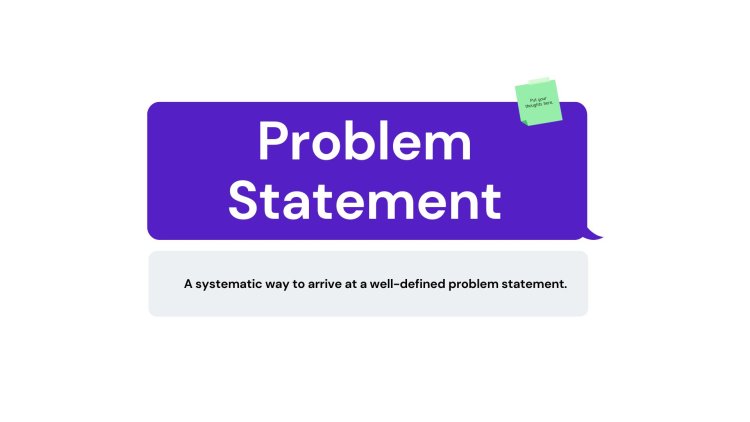Writing a Problem Statement for a Research Paper - A Comprehensive Guide
In this blog, I break down the process of crafting problem statements into simple steps. Whether you're experienced or just starting out, MyPerfectWords.com provide the tools to express your research questions clearly and confidently.
Share this Post to earn Money ( Upto ₹100 per 1000 Views )

Creating a clear problem statement can be challenging when starting a research paper. Many researchers struggle to express the main issue clearly and effectively.
Imagine reading a research paper that leaves you confused. This happens when the problem statement isn't well-written. Without it, both the writer and the reader may find the research unclear.
But don’t worry, MyPerfectWords.com has a solution for this. In this blog, I break down the process of crafting problem statements into simple steps. Whether you're experienced or just starting out, MyPerfectWords.com provide the tools to express your research questions clearly and confidently.
What is a Problem Statement?
A problem statement is a brief and clear explanation of the issue or challenge your research focuses on.
This statement is crucial because it outlines what your study will investigate, why it's important, and what gap it aims to fill.
Components of a Problem Statement in a Research Paper
An effective problem statement includes several key components:
Key Questions to Address When Writing a Problem Statement
To write an effective problem statement, address these key questions:
-
What is the Problem? Define the specific problem or knowledge gap your research addresses.
-
Why is it a Problem? Explain the importance of addressing this issue, considering its impact on the field, society, or specific stakeholders.
-
What is the Context? Provide the broader setting and existing research leading to the identification of the problem.
-
Who is Affected? Understand the stakeholders involved to grasp the real-world implications of your research.
-
What are the Limitations? Clearly state what aspects your study includes and excludes to maintain focus.
-
What is the Purpose of the Research? Clarify whether your goal is to explore, explain, describe, or evaluate aspects related to the identified problem.
-
How will the Problem be Investigated? Provide a preview of how you plan to address and explore the identified problem.
How to Write the Problem Statement for a Research Paper?
Writing a clear problem statement is crucial for a research paper. Follow these three steps to create a strong problem statement:
Step 1: Provide Context for Your Study
Start by presenting background information on your research topic.
Discuss the historical context, key concepts, and relevant theories to help readers understand the broader context of your study.
Conduct a literature review to highlight existing research on the topic, identifying gaps or controversies that justify your study.
Practical vs. Theoretical Research Problems
Practical research problems focus on addressing real-world issues with direct implications.
Theoretical research problems build and expand theoretical frameworks without immediate practical applications.
Tips for Practical Research Problems:
-
Relevance: Ensure your research directly addresses practical challenges.
-
Applicability: Focus on outcomes that can bring about real-world changes.
-
Feasibility: Choose practical research methodologies.
Theoretical Research Problems
Theoretical research problems focus on theoretical frameworks and understanding.
Tips for Theoretical Research Problems:
-
Conceptual Depth: Explore abstract concepts.
-
Knowledge Development: Contribute to theoretical foundations.
-
Innovation: Propose new models.
Step 2: Justify the Significance of Your Research
Articulate the significance of the problem identified in your literature review.
Explain why it's important to address this issue and how it contributes to advancing knowledge in your field.
Discuss the practical implications of your research and its potential benefits.
Step 3: Outline Specific Aims and Objectives
-
Aims: State the overall goal of your research.
-
Objectives: Break down the aim into specific, measurable, achievable, relevant, and time-bound (SMART) objectives.
-
Research Questions or Hypotheses: Formulate specific questions or hypotheses aligned with the problem.
If your problem statement not fits according to your professors’ requirement you can edit your research paper. MyPerfectWords.com offers research paper editing service for students to ensure their writing is clear and professional. With their help, you can perfect your work by taking your time, following expert advice, and focusing on details.
Research Problem Statement Example
Reviewing examples of research problem statements can guide you in creating your own.
Let's look at an example to see how these components work together:
Tips for Writing an Effective Problem Statement for Your Research Paper
Follow these tips to ensure your problem statement is clear and impactful:
-
Clarity is Key: Clearly articulate the problem to ensure readers understand from the outset.
-
Conciseness Matters: Keep your statement brief while covering essential aspects.
-
Relevance to the Field: Emphasize why the problem matters in your field.
-
Identify Gaps: Highlight gaps in knowledge to add value to your study.
-
Stay Focused: Keep your statement focused on the main issue.
-
Precision in Language: Use clear language without confusing jargon.
-
Objectives Link: Connect your problem statement to specific research objectives.
An outstanding problem statement is crucial for a successful research paper. It lays the foundation by defining the problem and outlining how it will be studied. Take your time to craft a clear statement, or seek professional help from MyPerfectWords.com, an online essay writing service for the students to get help in tough writing times.







